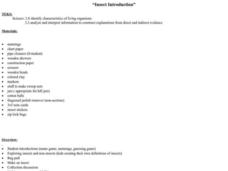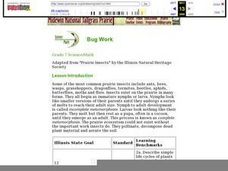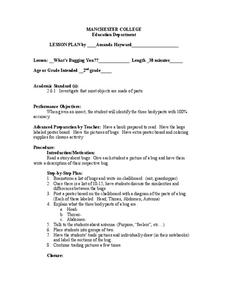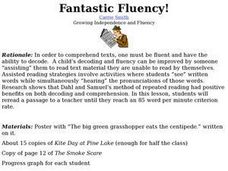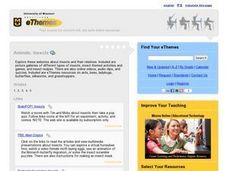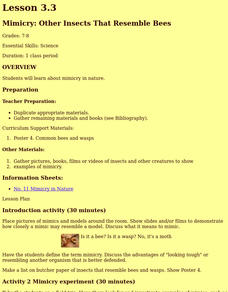Curated OER
How Manduca See
Third graders investigate how manduca sees and they discuss what they think the manduca might be thinking. They write a story about what an insect sees and does from the insect's perspective.
Curated OER
Insect Introduction
Second graders investigate insects and non-insects by creating their own definitions. They complete a series of activities relating to insects.
Curated OER
The Chain Gang
Students perform a food chain simulation to determine what happens when a food chain is broken.
Curated OER
Catch As Catch Can
Students capture and observe insects. Using provided netting, students design and create a butterfly net. They study many types of insects and their benefits. After identifying insects caught, students complete a graph. Students write...
Curated OER
Bug Work
Learners explore the life cycles of insects and how they interact with each other in the prairie to create a healthy ecosystem and viable food chain. They list animals or insects in their own community that are similar to the prairie...
Curated OER
Summarizing: James and the Giant Peach
Text marking and a T-chart format to distinguish important information from trivia help elementary readers summarize effectively. Encouraging readers to construct a chapter summary from paragraph-level topic sentences is another sound...
Curated OER
If I Could Talk Like the Animals. . .
Students read and discuss a film review of the animated movie Antz and then write a monologue from the perspective of a non-human organism.
Curated OER
Food Chains
Fourth graders study food chains, producers, consumers, and decomposers. They play a food chain game and create food chain mobiles or posters. They take a nature hike around the school and observe various parts of a food chain.
Curated OER
Going Buggy? Scavenger Hunt
In this insects worksheet, students utilize the Internet to access a specific website to locate the answers to five short answer questions involving insects.
Curated OER
Create An Insect
Young scholars create a new species of insect. They create a list of insect characteristics and use this as a springboard to draw an insect of their own. Students write a brief descriptive paragraphs about their insect, giving...
Curated OER
What's Bugging You?
Second graders investigate insects. In this parts of a whole, 2nd graders discuss what the three body parts of an insect are as well as the antenna. Students create their own insect labeling each body part and antenna.
Curated OER
Fantastic Fluency!
Students participate in repeated readings of an assigned passage to increase their reading fluency. They are assisted in their reading by seeing the words and hearing them read while working with a partner. After practicing, they read...
Curated OER
Spiders! Scary or Nice?
Students participate in a variety of cross-curriculur activities in order to explore spiders.
Curated OER
"Beeing" Expressive: Growing Independence and Fluency
Students practice independence and fluency in reading. They read and reread Honeybees until they become fluent. Students focus on expression while reading. Students read with expression while working on fluency. They read with a partner.
Curated OER
Insect Classification
Sixth graders learn the classification system of living organisms. They identify general body parts of an insect, learn insect classification into orders, families, genus and species, and classify given insects by using a scientific...
Curated OER
Species Charades
Students are introduced to a unit on endangered species. They study the diversity of endangered animals through a game of charades. After the game, students will discuss the animals that were acted out and why some of them are endangered.
Curated OER
The Frontier
Learners, given certain background information, list hardships that Laura Ingalls Wilder and other people that lived during the same time period went through. They interview someone who grew up in a different era than them.
Curated OER
Interesting Insects
Students discover the characteristics of insects. They explore insects through cooperative learning, group projects, hands on activities, and poetry. They gain knowledge of insect life cycles, habitat, and physical characteristics.
Curated OER
Animals: Insects
Learners use the Internet to examine insects and their relatives. They participate in online games and discover insect recipes.
Curated OER
Populations and Ecosystems
Sixth graders define terms prey, predator, and scavenger, describe predator-prey relationship, discuss effects of a lack of predators in an environment, and separate the role of the scavenger from that of the predator.
Curated OER
Letter G Word Search
In this letter g worksheet, students will focus on words beginning with the letter sound. Students will complete a word search and locate 8 words going across and down in the puzzle.
Curated OER
What Mary Jo Shared
In this What Mary Jo Shared worksheet, students read the book What Mary Jo Shared and answer short answer questions about it. Students complete 8 questions total.
Curated OER
Mimicry: Other Insects That Resemble Bees
Young scholars design a conceptual experiment to test whether mimics actually benefit from the fact they resemble other organisms or objects. They define the term mimicry. They focus on insects that resemble bees and wasps.

